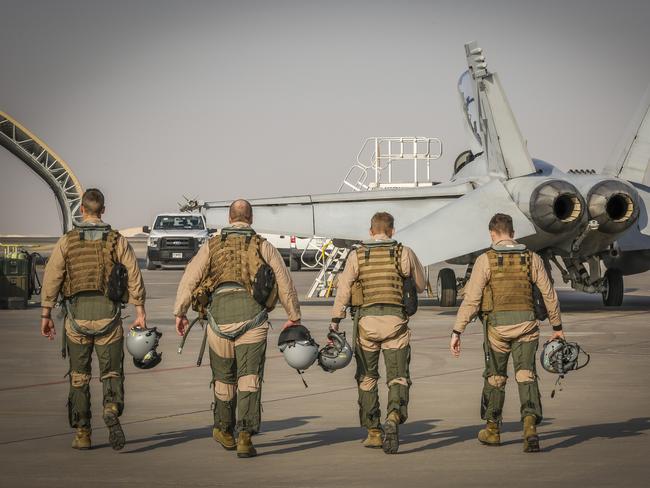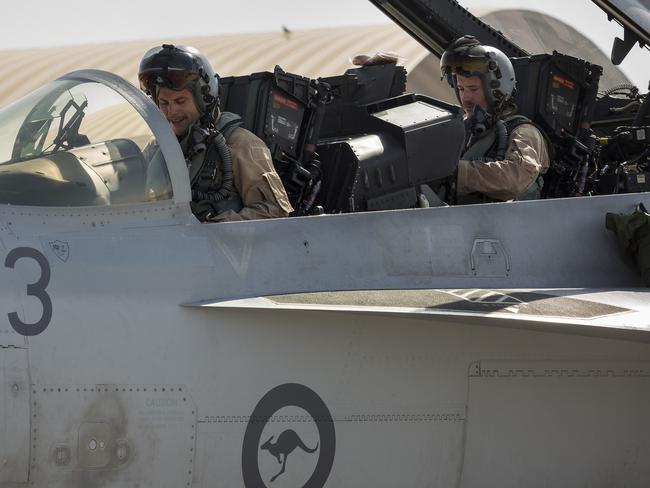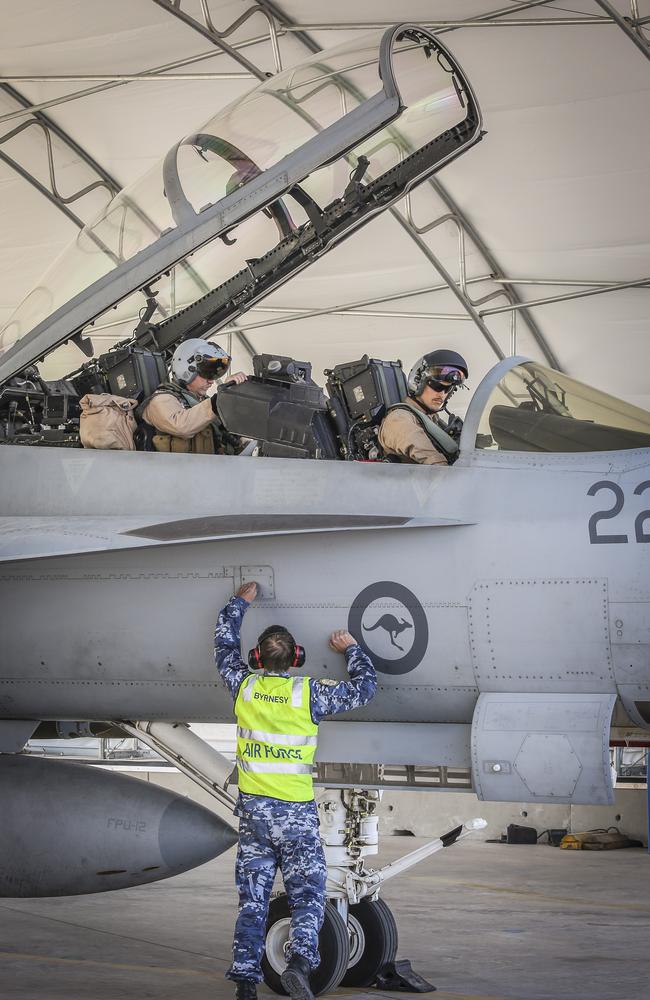AUSTRALIA’s frontline fighters have a serious problem.
The F/A-18F Super Hornet fighter and EA-18G Growler electronic warfare aircraft have had persistent complications with their life-support equipment.
Confusion. Dizziness. Panting. Racing hearts.
These are the symptoms that could send fighter aircraft — and their crew — into the ground.
But nobody is certain of what is causing it.
It's a deadly fault also experienced by the complex (and expensive) next-generation F-34 stealth strike fighter.
The Department of Defence has now confirmed RAAF pilots have been suffering the same physiological symptoms as their United States counterparts.
“Australian F/A-18F Super Hornet and EA-18G Growler aircrew have experienced events known as physiological episodes,” a defence statement concedes.
But finding the cause is proving to be difficult.
THIN AIR
The oxygen generation system used to supply aircrew at high altitudes and in intense manoeuvres is the prime suspect. But changing cabin pressures as fighters fly higher and harder may also be contributing.
Something is interrupting the flow of oxygen to and in their bodies. This is causing pilots and warfare officers to suffer what is officially termed hypoxia.
And the potentially fatal problem has been around for some time.
Flying officer Cameron Conroy of the RAAF’s 75 Squadron is believed to have passed out from hypoxia during a 1991 training flight. His crashed F/A-18C was later found in far north Queensland.
In a recent incident, the pilot and ground crew who connected themselves up to an Australian F/A-18’s breathing system reportedly suffered dizziness and confusion for up to 30 minutes afterwards. US Navy investigators believed this may have been caused by lubricants and engine fluids seeping into the oxygen system.

Queensland’s RAAF Base at Amberley was the scene of an international inquiry into the problem in May last year. Australia is working with the US Navy and NASA to resolve the problem. Until then, the Super Hornet and Growler will continue to fly operationally.
Australia’s defence department says measures are in place to mitigate the problem.
“The problem is extremely complex as contaminants can be generated by a number of sources both within and external to the aircraft,” their statement reads.
“In line with (a) risk management plan, Defence has established a program to reduce the occurrence and severity of physiological episodes, which includes: in-aircraft incorporation of a breathing air purification system (and an) increase of emergency oxygen supply to assist in aircrew recovery should an issue arise.”
But the problem goes well beyond the RAAF fleet of Super Hornets and Growlers.
The RAAF’s new F-35 stealth fighter appears to have the same problem.
ARRESTED DEVELOPMENT
Australian F-35 pilots were among 55 grounded last year in the United States. Five incidents of oxygen starvation in training aircraft between May and June prompted the
56th Fighter Wing of Luke Air Force Base, Arizona, to suspended all flying operations.
Pilots, doctors, mechanics and Lockheed Martin engineers were then brought together to discuss mitigating the problem.
A solution is yet to be found, though the aircraft is back in the air.
EXPLORE MORE: Australia’s preparing to fight in its cities
With a current development and acquisition price tag already at US$379 ($A502) billion for a total of 2443 F-35 aircraft — most destined for the US Air Force — the F-35 is the most expensive plane in history, and costs are set to rise further still.
Depending upon who you listen to, Australia’s 72 F-35’s are costing the country either $90 million per aircraft, or $206 million.
Other problems include persistent software bugs, technical glitches, design weaknesses and even a faulty eject system that risked killing pilots who weighed less than 62 kilograms.
LIFE SUPPORT
The number of physiological issues reported by US Hornet pilots increased between 10 and 90 per cent (depending on model type) between 2015 and 2016.
This is currently the subject of US Congressional investigations.
“As we sit here today, new F/A-18s are rolling off production at a cost of around $US69 ($A88) million per aircraft. At some point, paying $US69 ($A88) million for an aircraft we know has serious problems with its life-support system has to be questioned,” Democrat Niki Tsongas told a US House Armed Services committee earlier this month.

US navy investigators reported design changes to the oxygen generation system were being explored.
But it was difficult.
“As symptoms related to pressure fluctuations, hypoxia and contamination overlap, discerning a root cause is a complex process,” the investigators told the committee.
“Episodes of decompression illness typically accompany a noticeable loss or rapid fluctuation of cabin pressure, while the cause of hypoxic events is often not readily apparent during flight or post flight.”
So no underlying cause has yet been found.
UNUSUAL SUSPECTS
US Navy inquiries appear to generally be pointing the finger at leaking fluids entering aircraft air intakes.
It reports excessive use of grease on Hornet nose wheels appears to have contributed to most air supply contamination. Maintenance personnel have since been instructed to reduce the amount used, and to clean up any spillage.

But it is by no means the cause of all the hypoxia problems.
“There’s fluid for the radar cooling and so there’s a discharge port that basically could release some contaminants into the engine, because the engine is ingesting air all around the aeroplane,” the US navy told Congress during an earlier hearing into the issue in March.
“We’re looking really hard at everything possible the engine could ingest and contaminate the air we’re breathing.”
The Growler electronic warfare Hornets have an additional load of complex computers and systems which may be behind that aircraft’s higher incidence of hypoxia.
As a result, aircraft engineers were taking a shotgun approach to solving the problem.
“Internal components of the F/A-18 OBOGS (on-board oxygen generation system) have been redesigned to incorporate a catalyst to prevent carbon monoxide from reaching the pilot and provide an improved capability sieve material (filter),” US Navy investigators updated Congress last month.
“Hardware and software changes are in work for Super Hornets and Growlers to mitigate cabin pressurisation issues due to moisture freezing in the ECS lines. Component redesign, improved performance testing and newly established life limits will improve component reliability across all F/A-18 configurations.”
Video footage: Australian Department of Defence / RAAF

Add your comment to this story
To join the conversation, please log in. Don't have an account? Register
Join the conversation, you are commenting as Logout
Here’s what you can expect with tomorrow’s Parramatta weather
As spring moves into summer what can locals expect tomorrow? We have the latest word from the Weather Bureau.
Here’s what you can expect with tomorrow’s Parramatta weather
As spring moves into summer what can locals expect tomorrow? We have the latest word from the Weather Bureau.